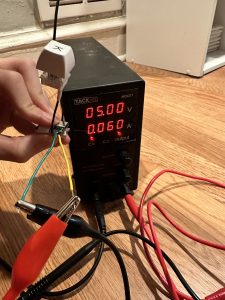Currently, we believe the most significant risks are that the wireless charging may not be able to deliver enough current to charge the battery sufficiently quickly and that the timeline may not allow for sufficient time to iterate both the programming software and the design of the 3D printed housing by the time the project is due. In terms of wireless charging, we are managing the risk by focusing development on getting a single switch to wireless charge correctly as a proof of concept, and having the remaining switches charge from USB as a backup. In terms of the software, we plan to focus on functionality first and then add any aesthetic improvements only if we have time. The same goes for the 3D printed housing. We may have to end up sacrificing some of the dimension design requirements to get the housing working at first, but then we plan to see what we can shave down after the fact.
We added a single switch PCB as an interface between the Cherry MX switch and the Seeed board. This was necessary as we found that our original plan of soldering wires between the switches and Seeed board would not meet the requirement of having hotswap capabilities. Additionally, it would make assembly nearly impossible as the switch would have to somehow be soldered inside the housing. This incurs an additional $1.50 cost per switch, but since the PCBs are so simple, it would cost a lot less if we ordered custom PCBs (~$5 on JLPCB). However, since we want to begin putting everything together more quickly, Amazon seemed to be the better choice. With this change, we may need to increase the dimensions of the housing to occupy a footprint of 25mmx22mm as current measurements of the battery + seeed setup already are pushing 22mm in the length dimension. We believe that this will not present that large of a usability issue however, since that is about the difference in spacing between a laptop keyboard and a Cherry MX style keyboard, and thus we do not expect users to be able to notice a difference.
There are no updates to the schedule currently. We have attached images of our charging testing and a video of the two switch connection working.
New tools:
To design the software, we would need to learn some sort of GUI creation library like PyGUI or GTK. To design the 3D printed housing, we plan on learning how to design using Autodesk, since it allows us to import Eagle footprints in order to give us an idea of the dimensions of the Seeed board and other components.

Video link: https://youtu.be/-SggOrEHb1I
